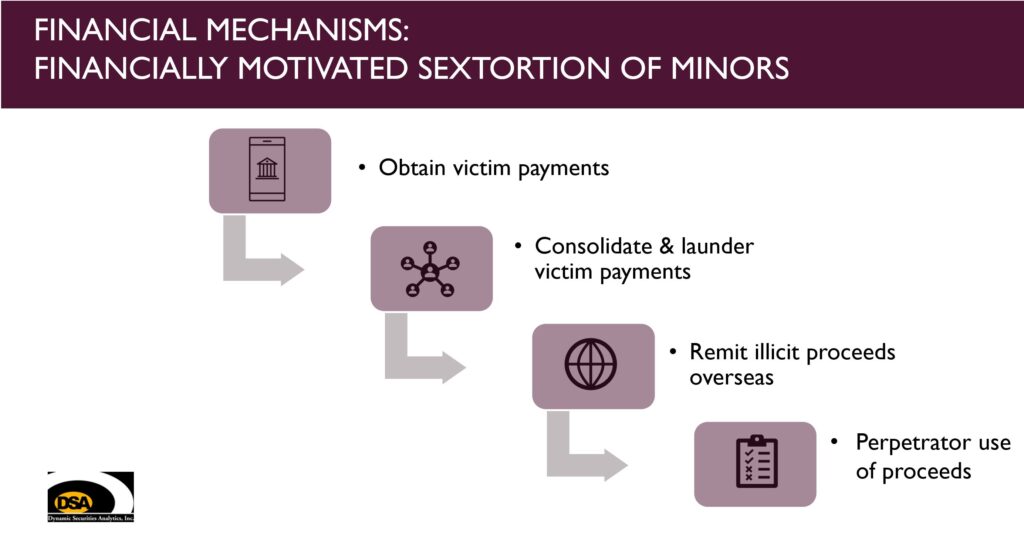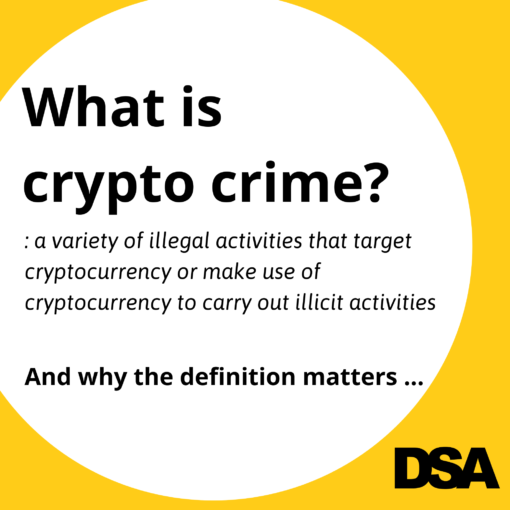This is the first article in a five-part series analyzing the financial mechanisms of financially motivated sextortion of minors. The series includes:
- Introduction to Financially Motivated Sextortion of Minors
- Victim Payments
- Consolidating Payments & Laundering Illicit Proceeds
- Remitting Illicit Proceeds Overseas & Using Proceeds
- Disrupting the Financial Mechanisms of Financially Motivated Sextortion of Minors
Part 1: Introduction to Financially Motivated Sextortion of Minors
What is Sextortion?
Sextortion is threatening to expose sexual or nude images of someone if they don’t yield to demands.
The demands (or motivation) can range from additional intimate imagery, returning to a romantic relationship, political, or financial.
The perpetrator(s) making the demand historically has included former romantic partners and sex offenders, and now includes Transnational Criminal Organizations.
The intimate images may have been obtained through hacks (phones, cloud storage, web cams), self-generated images shared during a relationship (or “catfish” relationship) or taken non-consensually.
If the sexual images are of a minor, there are special considerations and legal implications.
What is Financially Motivated Sextortion of Minors?
Financially motivated sextortion of minors is a crime in which an offender coerces a minor to create and send sexually explicit images or video. U.S. law defines “Offense Involving Child Pornography” to include the production of child pornography where offenders use deceit or non-physical forms of coercion, such as blackmail, to acquire child pornography depicting the targeting of minors.
Sextortion offenders often connect with teenage male victims through social media, online games, and messaging apps by creating profiles that appear to be young women. The FBI reports that predators may hack or purchase social media accounts known to a victim or create copycat accounts to appear as if they are someone the victim already knows. While posing as teenage girls, the predator secretly records explicit video calls with children or asks them to send sexually explicit pictures. After receiving sexually explicit content from a child, the offender threatens to release the material to friends, family, schoolmates, and/or social media followers unless the victim provides payment.
Why Examine the Financial Mechanisms of Sextortion?
Transnational Criminal Organizations (‘TCOs’) have targeted tens of thousands of teen victims for financially motivated sextortion, and more than twenty teens have committed suicide as a result.
In order to disrupt the mechanisms by which perpetrators profit from sextortion, we need to understand how funds are obtained, consolidated, laundered, remitted across borders, and spent.
Put simply — but for the ability to monetize the sextortion of children, both the amount of explicit imagery and the number of children exploited would be lower.
Components of Financially Motivated Sextortion of Children
Matthew Noyes, Cyber Policy & Strategy Director for the Secret Service outlined four components of transnational fraud schemes:
- The individuals conducting the fraud
- The victims
- Communication channels with victims [and amongst participants]
- Financial mechanisms to obtain and launder illicit proceeds

While this series focuses on the financial mechanisms used to obtain and launder illicit proceeds of financially motivated sextortion of minors. The other components — perpetrators, victims, and communication channels — inform the analysis.
Perpetrators of Financially Motivated Sextortion of Minors
For example, the financial mechanism analysis was informed by identifying TCO perpetrators based in Nigeria and Cote d’Ivoire (Ivory Coast). As background, a study by Thorn in partnership with the National Center for Missing & Exploited Children (‘NCMEC’) found that 47% of all reports linked to a country were linked to either Nigeria or Cote d’Ivoire.
Identifying the geographic location of perpetrators, determining if value needs to cross international borders, and the availability of various financial products/services, is useful in unraveling the financial mechanisms for different TCOs.
Victims of Financially Motivated Sextortion of Minors
Next, the victim component is key to understanding the financial mechanisms of financially motivated sextortion. The primary target are teenage boys. Teenage victims, as compared to adults, have more limited access and options with regard to financial products and services. But teens are not completely shut out the financial system. Part 2: Victim Payments will dive deeply into financial products and services teens access to pay extorters.
Communication Channels used in Financially Motivated Sextortion of Minors
Finally, financially motivated sextortion of minors is executed by fraudsters through certain favored communication channels. Some of those communication channels also integrate payments. If a perpetrator can blackmail a teen and receive payment through that same communication channel, well, that’s a win-win from their perspective.
Financial Flows Methodology
This analysis looks at the following financial flows:
- Victim payments
- Consolidation and laundering of victim payments
- Remittance of proceeds overseas
- Use of proceeds sextortionists

Data Sources for Financial Mechanisms of Financially Motivated Sextortion of Minors
The primarily source for this analysis is U.S. indictments against individuals with alleged involvement in financially motivated sextortion. An indictment is merely an allegation. Individuals are presumed innocent until proven guilty in a court of law. In one instance, the parties pled guilty and were sentenced to seventeen years in prison. A significant limitation to the analysis is the small sample size of four detailed indictments.
Victim Payments have received attention in reports such as the Thorn study mentioned above and by Paul Raffile et al in the report “A Digital Pandemic: Uncovering the Role of ‘Yahoo Boys’ in the Surge of Social Media-Enabled Financial Sextortion of Minors.”
However, the three next steps—consolidation & laundering, remitting overseas, and perpetrator use — are under-explored.
The analysis is supplemented by guilty pleas, media reports, foreign law enforcement reports, and the reddit sextortion forum (r/Sextortion). The sources did not provide uniform data, so all data elements are not available for all cases.
With the introduction behind us, it’s time to move on to Victim Payments.
Part 2 – Victim Payments in Financially Motivated Sextortion of Minors




